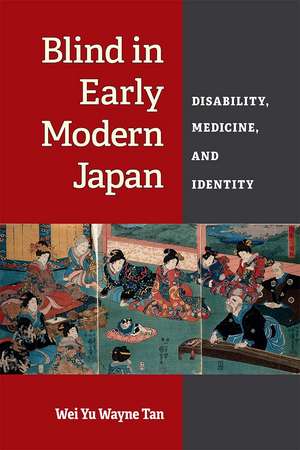Blind in Early Modern Japan: Disability, Medicine, and Identity: Corporealities: Discourses Of Disability
Autor Wei Yu Wayne Tanen Limba Engleză Paperback – 6 sep 2022
The book illustrates why disability must be assessed within a particular society’s social, political, and medical context, and also the importance of bringing medical history into conversation with cultural history. A Euro-American-centric disability studies perspective that focuses on disability and oppression, the author contends, risks overlooking the unique situation in a non-Western society like Japan in which disability was constructed to enhance blind people’s power. He explores what it meant to be blind in Japan at that time, and what it says about current frameworks for understanding disability.
Din seria Corporealities: Discourses Of Disability
-
 Preț: 214.26 lei
Preț: 214.26 lei -
 Preț: 246.08 lei
Preț: 246.08 lei - 8%
 Preț: 466.57 lei
Preț: 466.57 lei -
 Preț: 170.78 lei
Preț: 170.78 lei -
 Preț: 195.99 lei
Preț: 195.99 lei -
 Preț: 198.89 lei
Preț: 198.89 lei -
 Preț: 233.13 lei
Preț: 233.13 lei -
 Preț: 251.95 lei
Preț: 251.95 lei -
 Preț: 203.66 lei
Preț: 203.66 lei -
 Preț: 189.14 lei
Preț: 189.14 lei -
 Preț: 274.83 lei
Preț: 274.83 lei -
 Preț: 275.22 lei
Preț: 275.22 lei -
 Preț: 272.17 lei
Preț: 272.17 lei - 19%
 Preț: 476.36 lei
Preț: 476.36 lei - 5%
 Preț: 192.95 lei
Preț: 192.95 lei -
 Preț: 236.90 lei
Preț: 236.90 lei -
 Preț: 212.88 lei
Preț: 212.88 lei -
 Preț: 191.45 lei
Preț: 191.45 lei -
 Preț: 203.99 lei
Preț: 203.99 lei -
 Preț: 170.64 lei
Preț: 170.64 lei -
 Preț: 201.27 lei
Preț: 201.27 lei -
 Preț: 260.05 lei
Preț: 260.05 lei -
 Preț: 201.36 lei
Preț: 201.36 lei -
 Preț: 238.43 lei
Preț: 238.43 lei - 19%
 Preț: 479.70 lei
Preț: 479.70 lei -
 Preț: 234.84 lei
Preț: 234.84 lei -
 Preț: 297.31 lei
Preț: 297.31 lei - 19%
 Preț: 420.98 lei
Preț: 420.98 lei - 19%
 Preț: 448.99 lei
Preț: 448.99 lei -
 Preț: 171.84 lei
Preț: 171.84 lei -
 Preț: 204.58 lei
Preț: 204.58 lei -
 Preț: 236.63 lei
Preț: 236.63 lei -

Preț: 236.41 lei
Nou
Puncte Express: 355
Preț estimativ în valută:
45.24€ • 49.29$ • 38.12£
45.24€ • 49.29$ • 38.12£
Carte disponibilă
Livrare economică 02-16 aprilie
Preluare comenzi: 021 569.72.76
Specificații
ISBN-13: 9780472055487
ISBN-10: 0472055488
Pagini: 266
Ilustrații: 16 illustrations, 2 tables
Dimensiuni: 152 x 229 x 18 mm
Greutate: 0.36 kg
Editura: UNIVERSITY OF MICHIGAN PRESS
Colecția University of Michigan Press
Seria Corporealities: Discourses Of Disability
ISBN-10: 0472055488
Pagini: 266
Ilustrații: 16 illustrations, 2 tables
Dimensiuni: 152 x 229 x 18 mm
Greutate: 0.36 kg
Editura: UNIVERSITY OF MICHIGAN PRESS
Colecția University of Michigan Press
Seria Corporealities: Discourses Of Disability
Notă biografică
Wei Yu Wayne Tan is Associate Professor of History at Hope College.
Recenzii
Winner of the 2023 Patricia Buckley Ebrey Prize in East Asian History prior to 1800
Winner of the 2023 Outstanding Book Award
Winner of the Honorable Mention for the President's Book Award
"A thoughtful, deeply researched contribution to disability studies."
"...Tan’s book is an excellent opening for the history of blindness in Japan during its early modern period. Its theoretical frameworks, the power of lineages, and the background of consumer culture are excellent jumping-off points for historians of Japanese disabilities and non-European scholars who might follow."
"Highly recommended."
"The book is written in an engaging manner and is wonderfully illustrated with contemporary paintings, prints and photographs. . . . this is a book I will certainly revisit and recommend to anyone with an interest in the history of disability and Japanese society or the ways in which disability studies approaches have the potential to shed new light on experiences of disability beyond the global North and the present day."
"Tan takes care to describe and transcribe the images in the captions below them, a necessary and very welcome accessibility feature...The focus on electronic resources especially adds to the accessibility of Tan's research and its utility to anyone who wants a deeper look at Tokugawa medical and social practices around blindness."
"Ably and admirably striding several disciplinary boundaries, Tan's book is an empirically rich and straightforward account of blindness during the Edo period. More than simply presenting Tokugawa Japan as a case study in the larger corpus of the history of disability, it encourages scholars to reconsider approaches to writing about blindness and visual impairment."
"The book will reward a variety of readers, from those looking to understand general aspects of how Tokugawa society functioned, to those seeking information on blindness and blind people in Japanese history, to those interested in non-Western histories and views on disability, and many more."
"By drawing from a rich source base and employing new analytical frameworks, Tan takes topics familiar to Japan scholars--blind bards performing Heike, traveling blind female musicians, and the guild for blind men--and turns them into a bevy of new perspectives on what it meant to be blind in Tokugawa Japan."
"Blind in Early Modern Japan is an important contribution to the recent historiography of disability and the nascent 'Blindness Studies.' The author's choice to address a topic outside of the 'Global North' demonstrates the scholarly value of studies of blindness from a global historical perspective."
"Tan's work powerfully and insightfully documents the convergence of growing national and medical incentives that intersect in the early modern administration of blind-specific institutions of vocational rehabilitation."
"Tan's elaborate sociohistorical analyses clearly delineate how blindness was conceptualized in Tokugawa society and what this exclusive group of blind men did to advance their social status through the powerful national guild. He succeeds in presenting the lives of blind figures by utilizing published primary sources and digitized historical, literary, and medical manuscripts..."
Descriere
A history of the blind in Japan that challenges contemporary notions of disability
